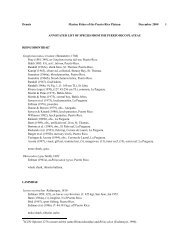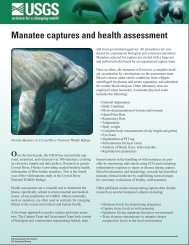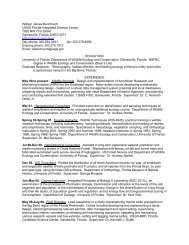Channa striata (Bloch, 1793) Chevron Snakehead
Channa striata (Bloch, 1793) Chevron Snakehead
Channa striata (Bloch, 1793) Chevron Snakehead
Create successful ePaper yourself
Turn your PDF publications into a flip-book with our unique Google optimized e-Paper software.
“ancient irrigation reservoirs” (Fernando and Indrassna,<br />
1969). They stated that there were more than 1,000<br />
tanks in Sri Lanka alone. In India, the chevron snakehead<br />
is described as a popular and highly prized fish,<br />
widely distributed, and the most economically important<br />
species of the genus (Talwar and Jhingran, 1992).<br />
<strong>Channa</strong> <strong>striata</strong> is one of three species of snakeheads<br />
commercially fished in Lake Jaisamand, the oldest<br />
reservoir in India (Rao and Durve, 1989). Fernando<br />
and Inrassna (1969) stated that it is the only species of<br />
snakehead in Sri Lanka of economic value, although<br />
three additional species (C. gachua, C. marulius, and<br />
C. punctata) are used as food fishes. It is also cultured<br />
in Vietnam (Pantulu, 1976; Bard, 1991), Thailand, Java<br />
(Hofstede and others, 1953), and the Philippines (Guerrero,<br />
2000). Bard (1991) noted that this species is the<br />
most expensive fish produced by aquaculture in northern<br />
Vietnam. Ali (1999) cited it as “a popular food fish<br />
in Malaysia” remarking that ricefields have provided<br />
the largest source of this fish. Populations in Malaysia<br />
are reported to be depressed due, apparently, to overfishing,<br />
raising costs for live specimens. China is<br />
culturing C. <strong>striata</strong> and some of the product is being<br />
canned for sale in Malaysia (Wan Ahmad, personal<br />
commun., 2001).<br />
Lee and Ng (1991) cited this species as the most<br />
economically important member of the snakeheads<br />
and noted that it is cultured throughout most of its<br />
range. Hofstede and others (1953) cited this species as<br />
bringing “the highest prices at the markets” in Indonesia.<br />
It is sold either fresh or alive in Cambodian<br />
markets (Rainboth, 1996). In the Danau Sentarum<br />
Wildlife Reserve of Kalimantan, chevron snakehead<br />
comprised 13 percent of the setline fish catch using<br />
small (size 12-16) hooks from the Kapuas River<br />
(Dudley, 2000).<br />
Ng and Lim (1990) and Lee and Ng (1991)<br />
indicated that <strong>Channa</strong> <strong>striata</strong>, along with C. micropeltes<br />
and C. lucius, are utilized for medicinal purposes,<br />
particularly in Indonesia and Malaysia. Mention was<br />
made of use in a postnatal diet and during recuperation<br />
from illnesses or surgery (Lee and Ng, 1991).<br />
While no specifics were given as to how the fish were<br />
used following surgery, a neighbor of one of the<br />
authors (WRC), a Malaysian by birth, said that the<br />
oils from the “haruan” are used to greatly reduce scarring.<br />
She added that she had seen the results and “it is<br />
true” that scar tissue is dramatically reduced to a<br />
minimum.<br />
Cream extracts of haruan tissues contain high<br />
levels of arachidonic acid, a precursor of prostaglandin,<br />
essential amino acids (particularly glycine), and<br />
polyunsaturated fatty acids necessary to promote<br />
prostaglandin synthesis. Treating wounds with these<br />
extracts has been demonstrated to promote synthesis of<br />
collagen fibers better than standard use of Cetrimide,<br />
an antimicrobial quaternary ammonium compound, thus<br />
increasing tensile strength (Baie and Sheikh, 2000).<br />
Lee and Ng (1991) indicated that the flesh of<br />
these larger snakeheads is rejuvenating following<br />
illnesses, prepared by being double-boiled with herbs,<br />
and only the soup is consumed. Nevertheless, for the<br />
soup to be effective in recovery, it is firmly believed<br />
that the fish must be killed just before cooking,<br />
dispatched with careful but firm blows to the head with<br />
a mallet. Herre (1924) reported much the same for the<br />
Philippines. Conceivably, this could be a reason that<br />
obtaining live snakeheads in live-food fish markets is<br />
considered important to some persons of southeast<br />
Asian descent living in the United States. Seale (1908)<br />
cited this species "as one of the most wholesome fishes<br />
and are given to invalids" in India.<br />
Bard (1991) noted that <strong>Channa</strong> <strong>striata</strong> is<br />
cultured in Vietnam and is a highly desired and expensive<br />
fish in the markets of Hanoi, with a price/kg<br />
matching that of beef.<br />
Environmental concerns: Adults of this species<br />
are considered to be highly predacious, ambush feeders<br />
on other fishes. In addition, their adaptability to living<br />
in turbid or clear waters, their apparent ability to tolerate<br />
subtropical to warm temperate climates, suggests<br />
the probability of establishment if introduced into<br />
waters of the extreme southern U.S. The apparent northern<br />
limit within its native range (32° N) is equivalent to<br />
a potential range from Savannah, Georgia, to just north<br />
of Ensenada, Baja California del Norte, México, in<br />
North America. Temperature regimes in the southwestern<br />
U.S. would permit establishment well north of 32º<br />
N, probably as far north as the Los Angeles basin, California;<br />
Phoenix, Arizona; or Las Cruces, New Mexico.<br />
Comments: Banerjee and others (1988)<br />
recorded the diploid chromosome number of <strong>Channa</strong><br />
<strong>striata</strong> from India as 40, but Donsakul and Magtoon<br />
(1991) reported a count of 44 for this species from<br />
Thailand, indicating that it represents a species<br />
complex.<br />
119







